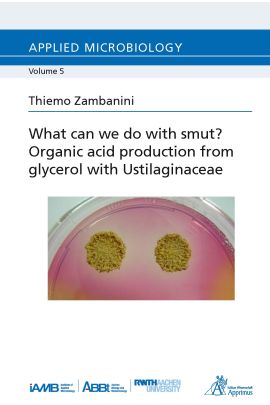The production process of biodiesel results in a huge waste stream of crude glycerol, reducing the economic and ecological advantage. Thus, the overall aim of this thesis was to establish a production process for organic acids from glycerol with Ustilaginaceae. In a screening of 126 Ustilaginaceae, two candidates for organic acid production were found - Ustilago trichophora for malic acid and U. vetiveriae for itaconic acid. Glycerol uptake and growth rate of both strains were improved by adaptive laboratory evolution. Selection of the best growing colony for each strain and medium and process optimization drastically improved the production.
The itaconic acid titer of U. vetiveriae TZ1 was increased to 35 g L‑1 (rate: 0.09 g L‑1 h‑1). Simultaneously about 60 g L‑1 malic acid were formed. First metabolic engineering approaches overexpressing the mitochondrial transporter Mtt1 and the regulator of the itaconic acid gene cluster Ria1, both from U. maydis, increased the itaconic acid titer by 1.5‑ and 2.0‑fold, respectively. Simultaneously, the malic acid titer was reduced by 96 % and 61 %, respectively.
For U. trichophora TZ1 the malic acid titer was improved to 200 g L‑1 produced within 264 h reaching a maximal production rate of 1.53 g L‑1 h‑1. Potential native target genes for metabolic engineering were identified after de‑novo genome sequencing. To enable the improvement of malic acid production with U. trichophora TZ1 by metabolic engineering, existing tools were investigated and adapted to be suitable for creation of overexpression mutants. Using these tools, overexpression mutants for two different malate dehydrogenases (Mdh1 and Mdh2), pyruvate-carboxylase (Pyc) and two different malic acid transporters (Ssu1 and Ssu2) were generated. While overexpression of Pyc did not improve malic acid production, transformants overexpressing Mdh1, Mdh2, Ssu1 and Ssu2 showed an up to 38 % increased malic acid production rate and an up to 54 % increased yield in shake flasks compared to U. trichophora TZ1. In bioreactor cultivations with the mutant overexpressing Ssu2, an increased production rate could not be observed. Due to a drastically lowered optical density, however, this strain had a 29 % higher specific production rate. Additionally, the product yield was improved by 1.4‑fold.
These results clearly strengthen the applicability of Ustilaginaceae as production organisms. By valorization of crude glycerol, the overall biodiesel bio‑refinery concept is improved.
| Autor | Zambanini, Thiemo |
|---|---|
| Lieferzeit | 3-4 Tage |
| Gewicht | 0.235 kg |
| Erscheinungsdatum | 02.03.2017 |
Applied Microbiology
What can we do with smut? Organic acid production from glycerol with Ustilaginaceae
Kurzbeschreibung
The aim of this thesis was to establish a process for organic acid production, to valorize the crude glycerol stream from biodiesel production. Screening 126 Ustilaginaceae, resulted in Ustilago trichophora for malate and U. vetiveriae for itaconate production. Production values of both strains were improved in iterative steps. The reached production values strengthen the applicability of Ustilaginaceae to valorize crude glycerol. By this, the overall biodiesel bio‑refinery concept is improved.

